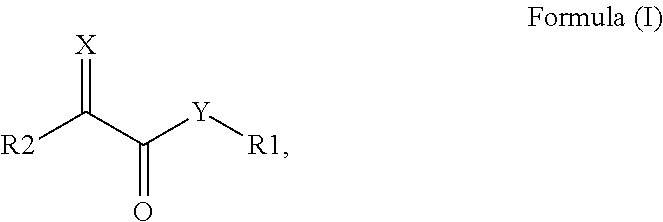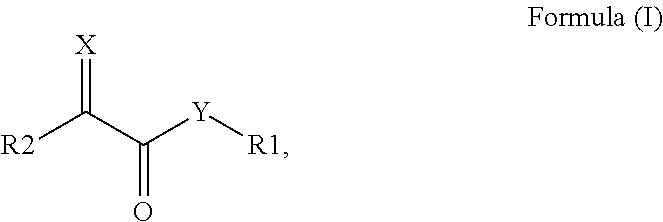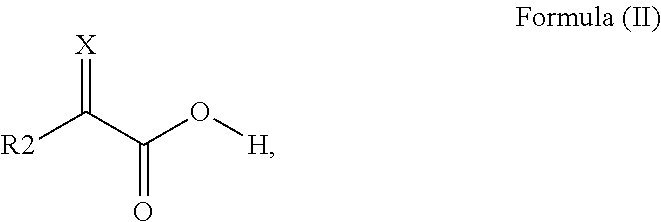Surface modified pigments and non-aqueous inks therewith
- Summary
- Abstract
- Description
- Claims
- Application Information
AI Technical Summary
Benefits of technology
Problems solved by technology
Method used
Image
Examples
example 1
[0206]This example illustrates the surface modification of the quinacridone pigment C.I. Pigment Red 122.
[0207]To a suspension of 5 g PR122 (15 mmol) in 50 mL toluene was added in one portion 2.4 mL of a 50% aqueous solution of glyoxylic acid (21 mmol). The reaction mixture was heated to reflux and stirred for 16 h. The mixture was allowed to cool down to 20° C. prior to the filtration. The solid residue was washed with toluene and acetone, and dried in a dry oven at 70° C. for 24 h. The dry solid PR122-MOD1 was obtained in about 80% yield and crushed prior to use for ink dispersion preparation.
example 2
[0208]This example illustrates the surface modification of a mixed crystal of two quinacridones, i.e. C.I. Pigment Violet 19 and C.I. Pigment Red 202.
[0209]It is believed that the surface modification occurs mainly on C.I. Pigment Violet 19 surface molecules:
[0210]To a suspension of 5 g PQMIX (16 mmol) in 60 mL toluene was added in one portion 2.4 mL of a 50% aqueous solution of glyoxylic acid (21 mmol) and 2.5 g of pure CH3COOH (43 mmol). The reaction mixture was heated to reflux and stirred for 16 h. The mixture was allowed to cool down to 20° C. prior to the filtration. The solid residue PQMIX-MOD1 was washed with toluene and acetone, and dried in a dry oven at 70° C. for 24 hours. The dry solid PQMIX-MOD1 was obtained in about 80% yield and crushed prior to use for ink dispersion preparation.
example 3
[0211]This example illustrates different methods for the surface modification of the diindolotriphenodioxazine pigment C.I. Pigment Violet 23.
[0212]First method: to a suspension of 200 g of PV23 (0.34 mol) in 1.4 L toluene was added in one portion 20 g of glyoxylic acid in its monohydrate form (0.21 mol) and 5 mL HCl 37% (0.06 mol). The reaction mixture was heated to reflux and stirred for 6 h. The mixture was allowed to cool down to 20° C. and water was then removed through partial distillation (about 15% of the reaction's volume). The mixture was filtrated, washed with toluene and acetone, and dried in a dry oven at 70° C. for 24 h. The dry solid PV23-MOD1 was obtained in quantitative yield.
[0213]Second method: to a suspension of 200 g of PV23 (200 g, 0.34 mol) in 1.4 L toluene was added in one portion 24 mL of a 50% aqueous solution of glyoxylic acid (0.21 mol) and 5 mL of HCl 37% (0.06 mol). The reaction mixture was heated to reflux and stirred for 6 h. The mixture was allowed t...
PUM
 Login to View More
Login to View More Abstract
Description
Claims
Application Information
 Login to View More
Login to View More - R&D
- Intellectual Property
- Life Sciences
- Materials
- Tech Scout
- Unparalleled Data Quality
- Higher Quality Content
- 60% Fewer Hallucinations
Browse by: Latest US Patents, China's latest patents, Technical Efficacy Thesaurus, Application Domain, Technology Topic, Popular Technical Reports.
© 2025 PatSnap. All rights reserved.Legal|Privacy policy|Modern Slavery Act Transparency Statement|Sitemap|About US| Contact US: help@patsnap.com



